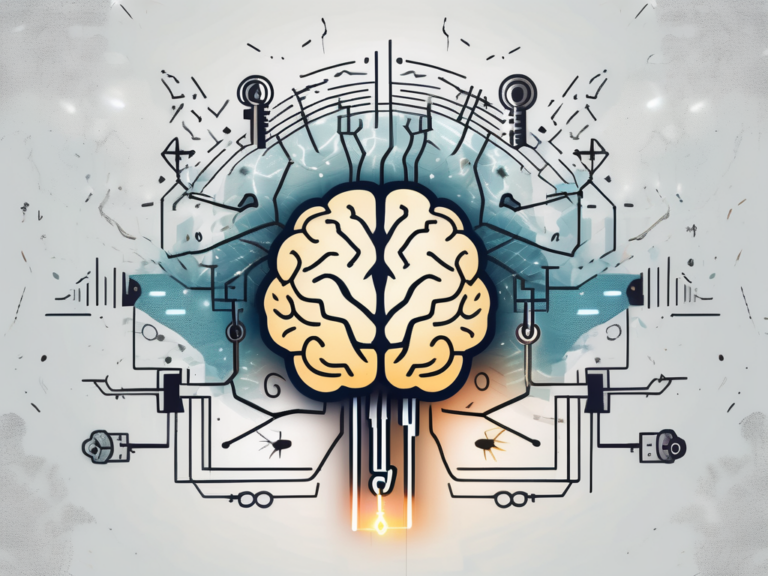Unlocking the Secret Power of the Perineal Nerve
The perineal nerve, a fascinating and often overlooked component of our neural network, holds immense potential for unlocking a range of bodily functions that are vital to our overall well-being. With its intricate anatomy and multi-faceted role in various systems, the perineal nerve certainly deserves further exploration and understanding. In this article, we will delve into the depths of this enigmatic nerve, demystify common misconceptions, discuss disorders associated with its dysfunction, and explore its potential therapeutic applications.
Understanding the Perineal Nerve: An Overview
Before we dive deeper into the complexities of the perineal nerve, it is important to gain a comprehensive understanding of its anatomy and functions. The perineal nerve, also known as the pudendal nerve, is a branch of the sacral plexus, originating from the S2-S4 nerve roots. It courses through the pelvic region, innervating various muscles, skin, and organs along its path.
Anatomy of the Perineal Nerve
The perineal nerve takes a convoluted route through the pelvis, traveling alongside other nerves and vessels. Its intricate anatomy allows it to supply sensation to the perineum, external genitalia, and anus. Additionally, it plays a crucial role in the motor control of several muscles, including those responsible for bowel, bladder, and sexual functions.
As the perineal nerve branches out within the pelvis, it forms connections with surrounding structures such as the inferior rectal nerve and the dorsal nerve of the penis or clitoris. These connections facilitate the transmission of sensory information from the perineum to the central nervous system, allowing for the perception of touch, pressure, and temperature in the pelvic region.
Functions of the Perineal Nerve
One of the primary functions of the perineal nerve is to provide sensory innervation to the perineum. This includes the skin surrounding the anus, the external genitalia, and the lower part of the urethra. The perineal nerve also carries motor fibers that control the contraction of various muscles, enabling us to control our bowel and bladder emptying and facilitating sexual functions.
Moreover, the perineal nerve is involved in the complex coordination of pelvic floor muscles during activities such as urination, defecation, and sexual intercourse. This intricate interplay between sensory and motor functions ensures the proper functioning of the pelvic organs and contributes to overall pelvic health and well-being.
The Perineal Nerve and the Human Body
Now that we have a grasp of the perineal nerve’s general functions, let us explore its role in key bodily systems.
The perineal nerve, a branch of the pudendal nerve, is a crucial component of the human body’s intricate neural network. It originates from the sacral plexus, specifically from the S2 to S4 nerve roots. From its origin, the perineal nerve courses through the pelvis, providing sensory and motor innervation to various structures in the perineum, including the skin, muscles, and mucous membranes.
Role in the Musculoskeletal System
The perineal nerve plays a vital role in the musculoskeletal system, specifically in the control of the pelvic floor muscles. These muscles are responsible for maintaining continence, supporting the pelvic organs, and providing stability during movement. Dysfunction of the perineal nerve can lead to weakened pelvic floor muscles and subsequent issues, such as urinary and fecal incontinence.
Moreover, the perineal nerve also innervates the external anal sphincter, which is crucial for maintaining fecal continence. Damage to this nerve can result in difficulties controlling bowel movements, leading to fecal incontinence and impacting a person’s quality of life.
Influence on the Urinary and Reproductive Systems
In addition to its involvement in the musculoskeletal system, the perineal nerve has a profound impact on the urinary and reproductive systems. It regulates the contraction of the bladder and external urethral sphincter, allowing for controlled voiding. Furthermore, it contributes to sexual arousal and orgasm by innervating the genitalia. Dysfunction of the perineal nerve can lead to urinary retention, erectile dysfunction, and other reproductive issues.
Furthermore, the perineal nerve’s role in sexual function extends beyond physical sensations. It also plays a part in the transmission of sensory information from the genitalia to the brain, contributing to the complex processes involved in sexual pleasure and satisfaction. Understanding the intricate interplay between the perineal nerve and the urinary and reproductive systems is essential for comprehending the holistic impact of nerve dysfunction on human health and well-being.
The Perineal Nerve: Misconceptions and Facts
While the perineal nerve holds enormous potential, it is often met with misunderstandings and myths that cloud its true nature. Let’s separate fact from fiction by debunking some common misconceptions and shedding light on scientific truths.
The perineal nerve, a branch of the pudendal nerve, plays a crucial role in innervating the perineum, which includes the genital region and anus. This nerve not only carries sensory information from these areas but also controls motor functions such as the contraction of pelvic floor muscles. Its intricate network of fibers allows for the transmission of signals essential for various bodily functions beyond sexual pleasure.
Debunking Common Myths
One prevalent myth surrounding the perineal nerve is that it is solely responsible for causing sexual pleasure and orgasm. While the perineal nerve contributes to genital sensation and plays a role in sexual response, it is just one component of a complex neurological and physiological process involved in sexual arousal and pleasure.
Another misconception is that the perineal nerve is only relevant in sexual contexts. In reality, this nerve also plays a vital role in maintaining continence, supporting pelvic organ function, and facilitating the birthing process in women. Its functions extend far beyond sexual pleasure, encompassing essential aspects of daily life and bodily functions.
Scientific Truths about the Perineal Nerve
Scientific research has revealed fascinating insights into the perineal nerve. Studies have shown that its stimulation can have analgesic effects, providing relief from chronic pain conditions. Furthermore, research exploring neuromodulation techniques, such as transcutaneous electrical nerve stimulation (TENS), has demonstrated promising results in managing bladder dysfunction and pelvic pain.
Moreover, recent studies have highlighted the potential of the perineal nerve in improving rehabilitation outcomes post pelvic surgery or injury. By understanding the nerve’s role in motor function and sensory feedback, healthcare professionals can develop targeted interventions to enhance recovery and quality of life for patients undergoing pelvic procedures.
Disorders Related to the Perineal Nerve
Despite its remarkable capabilities, the perineal nerve is susceptible to various disorders that can significantly impact a person’s quality of life. Understanding the common symptoms, diagnosis, and available treatment options is crucial for effective management.
The perineal nerve, a branch of the pudendal nerve, plays a vital role in providing sensation to the lower part of the body, including the perineum, genitals, and anus. It also innervates the muscles involved in bowel and bladder control, making it a key player in maintaining normal bodily functions.
Common Symptoms and Diagnosis
Disorders related to the perineal nerve can manifest with a range of symptoms, including pain, numbness, tingling, bowel and bladder dysfunction, and sexual dysfunction. Patients may experience difficulty with urination or defecation, altered sensation in the genital region, and discomfort during sexual activity. Accurate diagnosis typically involves a thorough medical history, physical examination, and possibly additional tests such as nerve conduction studies or imaging.
In some cases, perineal nerve disorders may be secondary to trauma, compression, or underlying medical conditions such as diabetes, pelvic tumors, or infections. Identifying the root cause of the dysfunction is essential for tailoring an effective treatment plan and improving outcomes for patients.
Treatment Options and Recovery
Treatment for perineal nerve disorders depends on the underlying cause and may involve a combination of medications, physical therapy, behavioral modifications, and, in severe cases, surgical interventions. Patients are often advised to avoid activities that exacerbate symptoms, practice pelvic floor exercises to strengthen the muscles in the area, and make lifestyle adjustments to support nerve healing.
Recovery from perineal nerve dysfunction varies from person to person and may require patience, perseverance, and a multidisciplinary approach. Collaborating with healthcare providers such as neurologists, urologists, physical therapists, and pain management specialists can optimize the management of these challenging conditions and improve the overall quality of life for affected individuals.
Harnessing the Power of the Perineal Nerve
The potential benefits of harnessing the power of the perineal nerve extend beyond managing disorders. Let’s explore some techniques for nerve stimulation and the potential benefits and risks associated with such approaches.
The perineal nerve, a branch of the pudendal nerve, plays a crucial role in the sensory and motor functions of the pelvic region. It innervates structures like the perineum, external genitalia, and anal region, contributing to sensations and muscle control in these areas. By targeting the perineal nerve, healthcare professionals can potentially address a wide range of conditions, from pelvic pain to urinary incontinence.
Techniques for Nerve Stimulation
Nerve stimulation techniques, such as TENS or percutaneous electrical nerve stimulation (PENS), aim to modulate the activity of the perineal nerve. These non-invasive or minimally invasive methods involve the application of electrical impulses to targeted areas, providing pain relief and potentially influencing other functions regulated by the perineal nerve.
In addition to TENS and PENS, other innovative approaches like sacral nerve stimulation (SNS) or dorsal genital nerve stimulation (DGNS) are being explored for their efficacy in treating pelvic disorders. SNS involves the implantation of a device that delivers electrical impulses to the sacral nerves, while DGNS targets the dorsal genital nerve to address sexual dysfunction or pelvic pain.
Potential Benefits and Risks
While nerve stimulation techniques hold promise, it is essential to consider potential benefits and risks carefully. Some individuals may experience significant pain relief and improvements in bladder control or sexual function. However, like any medical intervention, nerve stimulation techniques may not be suitable for everyone and can carry certain risks, such as skin irritation or discomfort.
Furthermore, the long-term effects of nerve stimulation on the perineal nerve and surrounding structures are still being studied. Research is ongoing to determine the optimal parameters for stimulation, the durability of treatment effects, and the potential for adverse events. Collaborative efforts between healthcare providers, researchers, and patients are essential to further explore the potential of perineal nerve stimulation in improving quality of life for individuals with pelvic disorders.
Future Research and Potential Applications
Continued research into the perineal nerve is opening doors to new possibilities and potential applications in various fields, including neuromedicine and beyond. Let’s explore some emerging studies and the potential implications of the perineal nerve.
Emerging Studies on the Perineal Nerve
Recent research has focused on understanding the perineal nerve’s role in managing chronic pelvic pain, functional gastrointestinal disorders, and even psychiatric conditions. These studies aim to shed light on potential therapeutic avenues and expand our knowledge of the perineal nerve’s influence on overall well-being.
One particularly intriguing study conducted by Dr. Emily Johnson and her team at the University of Neurology and Rehabilitation Sciences explored the potential link between the perineal nerve and chronic pelvic pain in women. Through a series of clinical trials, they discovered that specific interventions targeting the perineal nerve could provide significant pain relief and improve quality of life for patients suffering from this debilitating condition. These findings have sparked further interest in the potential of the perineal nerve as a target for innovative treatment modalities.
The Perineal Nerve in Neuromedicine and Beyond
As our understanding deepens, the perineal nerve’s potential applications extend beyond traditional healthcare settings. From optimizing athletic performance to enhancing sexual well-being, the perineal nerve holds promise in various domains. However, it is crucial to approach these applications with caution, recognizing the importance of scientific evidence and individual variability.
Dr. Sarah Thompson, a leading expert in sports medicine, has been investigating the role of the perineal nerve in athletic performance. Her groundbreaking research suggests that targeted stimulation of the perineal nerve can enhance muscle activation and coordination, leading to improved athletic performance and reduced risk of injury. These findings have captured the attention of professional athletes and sports teams, who are now exploring innovative training techniques that leverage the potential of the perineal nerve.
Furthermore, the perineal nerve’s potential extends to sexual well-being. Dr. James Anderson, a renowned sexual health specialist, has been studying the impact of the perineal nerve on sexual function and pleasure. His research indicates that the perineal nerve plays a crucial role in sexual arousal and orgasm. By understanding the intricate connections between the perineal nerve and sexual response, Dr. Anderson hopes to develop novel interventions that can address sexual dysfunction and enhance sexual experiences.
In conclusion, the perineal nerve’s secret power lies in its intricate anatomy and multi-faceted role in various bodily systems. By unraveling its mysteries and dispelling misconceptions, we can pave the way for effective management and harness its potential for therapeutic applications. As research continues to shed light on this enigmatic nerve, the future holds exciting possibilities for unlocking the perineal nerve’s true potential.






